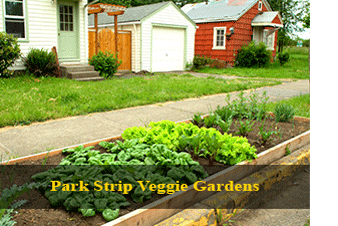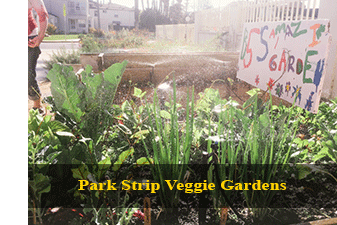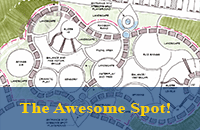Author: Chad Kennedy, Landscape Architect, ASLA
 In a society which largely benefits from bountiful and readily available fresh food resources, it is almost unfathomable that communities exist where young children grow up with limited or no access to healthy foods and fresh fruits and vegetables. Even in the Central Valley of California where agricultural land is far more common than urban land, and where it isn't uncommon to see tomatoes and other produce adorning the roadside (the result of overloaded produce trucks and lead footed truck drivers), there are lower income communities that have no grocery stores or markets within walking distance. This scenario has been recognized by many who have started developing ways to bring healthy foods and education to these communities. One method, made exponentially more popular by Ron Finely's TED talk "A Guerilla Gardener in South Central LA" is park strip vegetable gardens. Finley highlighted the core idea around these gardens when he spoke of the food desert he lived in, the fact that "the drive-thrus are killing more people than the drive-bys" (shootings), and that communities like his in South Los Angeles have disproportionately high obesity levels. 1 Others have also taken steps to address these troubling trends, such as the SF Giants organization. The Giants are trying to raise awareness about access to healthy local foods through opening a garden at AT&T park which serves as a nutritional classroom and, on game days, as an educational experience for fans. 3 Though the concept of park strip gardens may seem to be a common sense response to a societal need, it is surprisingly controversial. The following summary will discuss what park strip gardens are, the controversy surrounding them, and basic benefits that may be realized through their implementation.
In a society which largely benefits from bountiful and readily available fresh food resources, it is almost unfathomable that communities exist where young children grow up with limited or no access to healthy foods and fresh fruits and vegetables. Even in the Central Valley of California where agricultural land is far more common than urban land, and where it isn't uncommon to see tomatoes and other produce adorning the roadside (the result of overloaded produce trucks and lead footed truck drivers), there are lower income communities that have no grocery stores or markets within walking distance. This scenario has been recognized by many who have started developing ways to bring healthy foods and education to these communities. One method, made exponentially more popular by Ron Finely's TED talk "A Guerilla Gardener in South Central LA" is park strip vegetable gardens. Finley highlighted the core idea around these gardens when he spoke of the food desert he lived in, the fact that "the drive-thrus are killing more people than the drive-bys" (shootings), and that communities like his in South Los Angeles have disproportionately high obesity levels. 1 Others have also taken steps to address these troubling trends, such as the SF Giants organization. The Giants are trying to raise awareness about access to healthy local foods through opening a garden at AT&T park which serves as a nutritional classroom and, on game days, as an educational experience for fans. 3 Though the concept of park strip gardens may seem to be a common sense response to a societal need, it is surprisingly controversial. The following summary will discuss what park strip gardens are, the controversy surrounding them, and basic benefits that may be realized through their implementation.
What is a Park Strip Garden?
Understanding that eighty percent of the United States population lives within urban environments, and the fact that more food is now imported into the country than ever before, the need for locally available food sources has become increasingly important. 2 Park strip gardens can be considered a single component in a much larger and complex food system that supports communities. Local food systems are intrinsically related to community benefits and relationships which improve health, social interaction, economics and sense of place for local communities. 4
First Lady, Michelle Obama, has made it her charge to address healthier kids and families with her "Let's Move" initiative which has five core goals: creating a healthier start for children, empowering parents and caregivers, providing healthy foods in schools, improving access to healthy affordable foods and increasing physical activity. 7 Interestingly, plant strip vegetable gardens help to accomplish all of these goals.
A loose definition of Park Strip Vegetable Gardens is the production of food products for consumption within the strip of landscape between the sidewalk and the street. Gardeners plant typical vegetable garden plant species within this underutilized space, including eggplant, tomatoes, cucumber, zucchini, carrots, etc., based upon what the users will use with recipes in their daily cooking after harvesting. As these spaces are actually public-right-of-way there are often restrictions in place to protect the public. These restrictions might include plant heights, limitations of messy fruits, raised bed options, and thorny plants.5
The Controversy 
The public/private nature of these often un-used spaces is the driving reason that park-strip gardens are controversial. These gardens are simply not comprised of the traditional plant material with which City planners and staff are familiar with. Moreover, many and many municipal codes either ban the use of edible plants outright or contain vague language revolving around plant material that creates regulatory confusion. In some communities, citizens are fined for implementing these gardens and even face potential criminal charges. As reported by ABC News, a woman in Oak Park, Michigan was criminally charged for growing a vegetable garden in her front yard.6 Ron Finely, and others he teams with, were also fined for planting park strips in Los Angeles. The City of Los Angeles recently, however, in large part due to Ron Finley's advocacy efforts, adopted changes to their policies allowing produce to be grown in park strips.2 Other communities have started to embrace the movement as well. The City of Seattle's website, for example, dedicates a whole page to "Growing Food in Planting Strips," complete with tips and potential appropriate plant species. Seattle and other cities' support of this practice is evidence of increased acceptance and awareness of the potential benefits of park strip gardens.5
Potential Benefits from Park Strip Vegetable Gardens
At the surface, park strip gardens may be viewed simply as a trend. In reality, this practice impacts public well-being on a number of levels, ranging from health benefits to social and economic benefits. The North American Urban Agriculture Committee has documented many benefits of urban agriculture that would certainly apply to park strip gardens as well.
- Improved awareness of environmental stewardship.
- Local supply of food decreases energy needs for transport, delivery and refrigeration. (Travel distances for food can range between 1,500 and 2,500 miles before actual consumption)
- Improved community pride and value.
- Increase in economic development as demand rises for locally grown and available foods.
- Limits spoils caused by transportation. (Nearly 50% of transported food is unusable due to spoilage)
- Improved supply of local foods in the event of emergencies and natural disasters. (The Department of Homeland Security suggests communities should be able to supply 30% of their supplies locally, though currently the average is closer to 5%)
- Improved activity and health by those directly involved in the cultivation and harvest of local foods. (Studies have shown that gardening three to four times a week is comparable to moderate walking and biking).
- Increase of green space which is tied to the reduction of stress, moderation of emotion and lowering of blood pressure.
- Functional use of otherwise unused space.
- Reuse of green waste throughout the urban environment in a cyclical fashion. 1
In addition, food grown at a small scale, harvested when ripe, and prepared shortly after harvesting is much more flavorful than commercially available foods. An interesting survey completed in Philadelphia reported additional reasons and benefits for which community gardeners engaged in urban agriculture. The results were: "recreation (21%), mental health (19%), physical health (17%), produce quality and nutrition (14%), spiritual reasons (10%), cost and convenience (7%), self-expression/self-fulfillment (7%) and other (5%)."1 Another survey, from the general population, revealed that the majority of respondents believed urban agriculture's main purpose and benefit was to supplement household foods.
There are many ways to bring agriculture into the urban environment, provide fresh fruits and vegetables to those with little access, and expose young children to the fascinating secrets of nature in the garden. Park strip vegetable gardens are just one, of the many, within the urban agriculture tool box. Hopefully with additional advocacy and grass root community group efforts, more park strip vegetable gardens, community gardens, vacant lot gardens, vertical gardens, and other innovative vegetable gardens will grace the streets of our highly urban cities.
To learn more about landscape architecture topics, please visit the publications section of our website by clicking here.
1-Community Food Security Coalition's North American Urban Agriculture Committee. Urban Agriculture and Community Food Security in the United States: Farming from the City Center to the Urban Frindge. October 2003.
2-Blackmore, Willy. L.A. Finally Realizes Front-Yard Gardens Are A Good Thing. Takepart.com. http://www.takepart.com/article/2013/08/16/fines-parkway-gardens-suspended-los-angeles. Posted 08-16-13. Accessed 05-29-16
3-Giants News. Giants and Bon Appétit Management Company Open The Garden at AT&T Park. http://m.giants.mlb.com/news/article/81371866/giants-and-bon-app233tit-management-company-open-the-garden-at-att-park. Posted 7-24-14. Accessed 05-29-16
4-Hendrickson, Mary K. and Mark Porth. Urban Agriculture: Best Practices and Possibilities. University of Missouri Extension, Division of Applied Social Sciences. June 2012.
5-Hoffman, Ray. Growing Food in Planting Strips. City of Seattle. http://www.seattle.gov/util/EnvironmentConservation/MyLawnGarden/FoodGardening/PlantingStrips/index.html. Accessed 05-29-16
6-Kirpalani, Reshma. Woman Faces Jail Time For Growing Vegetable Garden in Her
Own Front Lawn. ABC News. http://abcnews.go.com/US/vegetable-garden-brings-criminal-charges-oak-park-michigan/story?id=14047214. Posted July 12, 2011. Accessed 05-29-16
7-Let's Move. America's Move to Raise A Healthier Generation of Kids. http://www.letsmove.gov/about. Accessed 05-29-16
 In a society which largely benefits from bountiful and readily available fresh food resources, it is almost unfathomable that communities exist where young children grow up with limited or no access to healthy foods and fresh fruits and vegetables. Even in the Central Valley of California where agricultural land is far more common than urban land, and where it isn't uncommon to see tomatoes and other produce adorning the roadside (the result of overloaded produce trucks and lead footed truck drivers), there are lower income communities that have no grocery stores or markets within walking distance. This scenario has been recognized by many who have started developing ways to bring healthy foods and education to these communities. One method, made exponentially more popular by Ron Finely's TED talk
In a society which largely benefits from bountiful and readily available fresh food resources, it is almost unfathomable that communities exist where young children grow up with limited or no access to healthy foods and fresh fruits and vegetables. Even in the Central Valley of California where agricultural land is far more common than urban land, and where it isn't uncommon to see tomatoes and other produce adorning the roadside (the result of overloaded produce trucks and lead footed truck drivers), there are lower income communities that have no grocery stores or markets within walking distance. This scenario has been recognized by many who have started developing ways to bring healthy foods and education to these communities. One method, made exponentially more popular by Ron Finely's TED talk 
 O'Dell Engineering has just published its new website. The new design is more intuitive, helpful, playful, and representative of the firm's expertise. Click
O'Dell Engineering has just published its new website. The new design is more intuitive, helpful, playful, and representative of the firm's expertise. Click 
